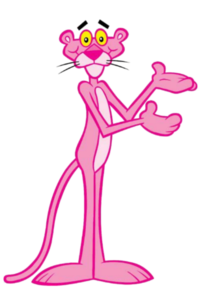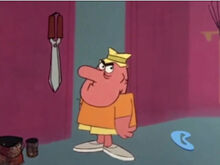


Pink Panther is a fictional animated character who appeared in the opening and closing credit sequences of every film in the Pink Panther series except for A Shot in the Dark and Inspector Clouseau. In the storyline of the original film, "the Pink Panther" was the name of a valuable pink diamond; in the animated credits this was humorously translated to a "real" pink panther.

The character's popularity spawned a spin-off franchise of theatrical shorts, merchandise, a comic book, and television cartoons. He starred in 124 short films, 10 television shows and three prime time specials. The character is closely associated with the evocative "Pink Panther Theme".
DePatie-Freleng/United Artists cartoons[]
The animated Pink Panther character's initial appearance in the live action film's title sequence, directed by Friz Freleng, was such a success with audiences and United Artists that the studio signed Freleng and his DePatie-Freleng Enterprises studio to a multi-year contract for a series of Pink Panther theatrical cartoon shorts. The first entry in the series, 1964's The Pink Phink, featured Pink harassing his foil, a little white mustachioed man who is actually a caricature of Friz Freleng (this character is officially known as "The Little Man" and would later be known as "Big Nose" in Pink Panther and Pals), by constantly trying to paint the Little Man's blue house pink. The Pink Phink won the 1964 Academy Award for Animated Short Film, and subsequent shorts in the series, usually featuring the Pink Panther opposite the Little Man, were successful releases.
In an early series of Pink Panther animated cartoons, Pink generally remained silent, speaking only in two theatrical shorts, Sink Pink and Pink Ice. Rich Little provided Pink's voice in the latter shorts, modelling it on that of David Niven (who had portrayed Clouseau's jewel thief nemesis in the original live-action film). Years later, Little would overdub Niven's voice for Trail of the Pink Panther and Curse of the Pink Panther, due to Niven's ill health. All of the animated Pink Panther shorts utilized the distinctive jazzy theme music composed by Henry Mancini for the 1963 feature film, with additional scores composed by Walter Greene or William Lava.
Critical reception[]
Animation historian Jerry Beck has called the Pink Panther "the last great Hollywood cartoon character", noting that "Classic animation pretty much died in the '60s, everyone had kind of bailed out. But his creators didn't rest on their laurels. They didn't make the cartoons to look like Warner Bros. cartoons, or Disney cartoons, or the UPA look of Mister Magoo and Gerald McBoing-Boing. They came up with their own clever new style. The only other important cartoon of the '60s was Yellow Submarine."
The Pink Panther was a notable contribution to the animation art form. Top animation directors such as Hawley Pratt, Gerry Chiniquy, Robert McKimson, and Sid Marcus contributed to a distinctive style, supported by master story writer John W. Dunn. Produced after theatrical cartooning's golden age of the 1940s and 50s, they were constrained to the limited animation techniques applied to Saturday morning cartoons of the 1960s and after. Within these limitations, the Pink Panther made creative use of absurd and surreal themes and visual puns and an almost completely wordless pantomime style, set to the ubiquitous Pink Panther theme and its variations by Henry Mancini. The overall approach is reminiscent of the classic silent movies of Charlie Chaplin and Buster Keaton.
Cultural references were more muted and stylized, resulting in a cartoon with longer-term, more cross-cultural appeal not shared by contemporaries such as Yogi Bear and The Flintstones, with their greater reliance on contemporary American pop culture. The Pink Panther also remained constrained to the classic six-minute form of theatrical shorts, while contemporaries expanded into longer, sitcom-like storylines, up to a full 30 minutes of broadcast TV in the case of The Flintstones. Freleng's colleagues credit his sense of creative timing as a key element to the cartoon's artistic success. Freleng himself regarded the Pink Panther as his finest achievement and the character he most identified with, according to family and colleagues interviewed on the 2006 DVD release.

